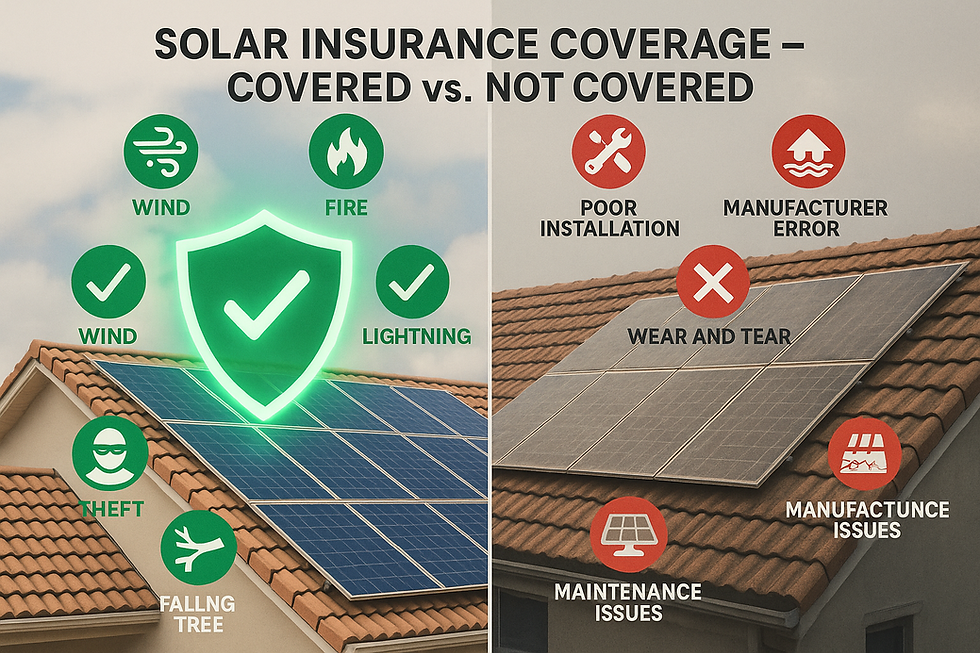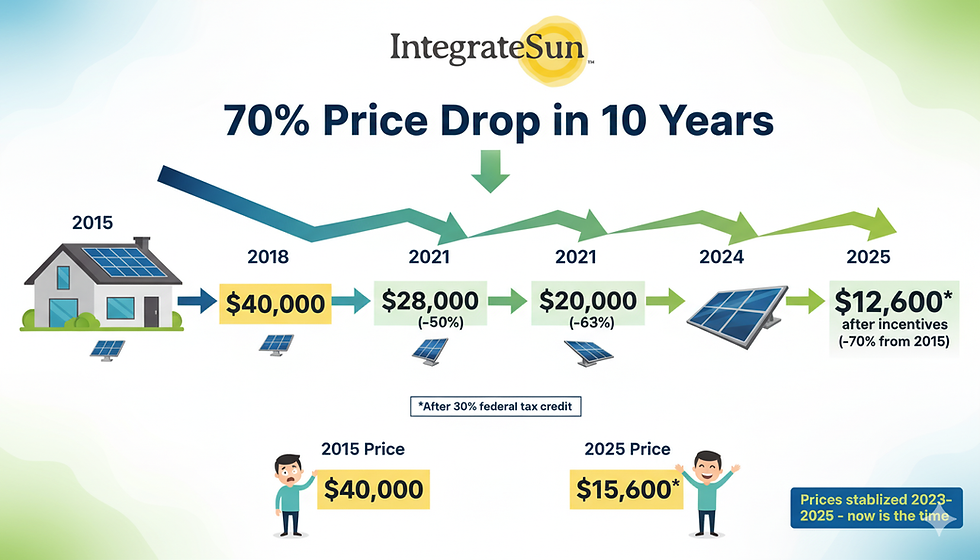Does Homeowners Insurance Cover Solar Panels? Complete 2025 Guide
- IntegrateSun Company
- Jul 11
- 5 min read

With over 4.2 million American homes now equipped with solar panels, homeowners are increasingly concerned about protecting their solar investments. The good news? Most homeowners insurance policies do cover solar panels, but the coverage details can be complex and vary significantly based on your specific situation.
Understanding your solar panel insurance coverage is crucial for protecting an investment that typically ranges from $15,000 to $30,000. This comprehensive guide will walk you through everything you need to know about homeowners insurance and solar panels in 2025.
The Short Answer: Yes, But With Important Conditions
Most standard homeowners insurance policies cover solar panels as part of your dwelling coverage, but there are several key factors that determine your exact coverage:
For Roof-Mounted Solar Panels: These are typically covered under your dwelling coverage since they're considered a permanent attachment to your home's structure. Your existing coverage limits usually extend to include the solar panels without requiring a separate policy.
For Ground-Mounted Solar Panels: These systems are generally covered under your personal property coverage, which may have different limits and deductibles than your dwelling coverage.
The Ownership Factor: This is crucial – your insurance only covers solar panels you own. If you're leasing panels or have a Power Purchase Agreement (PPA), the solar company typically maintains insurance coverage for the equipment.
Types of Coverage That Protect Your Solar Investment

Dwelling Coverage for Roof-Mounted Systems
When solar panels are permanently attached to your roof, they become part of your home's structure. This means they're covered under your dwelling coverage, which typically includes:
Replacement cost coverage for the panels themselves
Roof repair costs if the mounting system causes damage
Electrical system repairs related to solar installation
Removal and reinstallation costs if roof repairs are needed
Personal Property Coverage for Ground-Mounted Systems
Ground-mounted solar arrays are treated as personal property, similar to a shed or fence. This coverage typically includes:
Theft protection for portable components
Vandalism coverage for intentional damage
Weather damage from covered perils
Accidental damage from falling trees or debris
Additional Living Expenses Coverage
If solar panel damage makes your home uninhabitable, this coverage pays for:
Temporary housing costs while repairs are completed
Increased utility bills if you lose solar power generation
Food spoilage from power outages related to solar system damage
What's Covered vs. What's Not

Covered Perils
Standard homeowners insurance typically covers solar panel damage from:
Wind and Hail Damage: The most common cause of solar panel insurance claims. Modern panels are designed to withstand winds up to 140 mph, but severe storms can still cause damage.
Fire Damage: Whether from electrical faults, lightning strikes, or external fires, solar panels are covered for fire-related damage.
Theft and Vandalism: Solar panels are valuable targets for theft. Your policy covers stolen panels, inverters, and other components.
Falling Objects: Damage from falling trees, aircraft, or debris is typically covered.
Lightning Strikes: Direct lightning strikes or electrical surges that damage your solar system are covered.
Common Exclusions
Wear and Tear: Normal degradation over time isn't covered. This includes gradual efficiency loss or aging components.
Manufacturer Defects: Faulty equipment falls under manufacturer warranties, not insurance coverage.
Poor Installation: Damage caused by improper installation is excluded unless the installer carries professional liability insurance.
Flooding: Standard policies don't cover flood damage – you'd need separate flood insurance.
Maintenance Issues: Damage from neglected maintenance or cleaning isn't covered.
Coverage Limits and Replacement Costs

Understanding Your Coverage Limits
Your solar panels are covered up to your dwelling coverage limit, but this doesn't mean unlimited coverage. Key considerations include:
Adequate Coverage Limits: Ensure your dwelling coverage limit accounts for your solar installation. A $25,000 solar system on a $200,000 home should increase your coverage accordingly.
Replacement Cost vs. Actual Cash Value: Most policies offer replacement cost coverage, which pays for new panels at current prices. Actual cash value coverage deducts depreciation, providing less protection.
Technology Upgrades: If your panels are discontinued, insurers typically cover "like kind and quality" replacements, which may include newer, more efficient models.
When to Increase Coverage
Consider increasing your dwelling coverage if:
Your solar system cost exceeds 10% of your home's value
You have a large ground-mounted system
You've added battery storage or other expensive components
Your panels include premium features like monitoring systems
Leased vs. Owned Solar Panels
Owned Solar Systems
When you purchase your solar panels:
Full insurance responsibility rests with you
Coverage includes all components and installation
Claims process goes through your insurance company
Deductible applies to any covered damage
Leased Solar Systems and PPAs
With leased panels or Power Purchase Agreements:
Solar company maintains insurance on the equipment
Your policy may cover roof damage from installation
Responsibility gaps can exist for certain types of damage
Coordination required between insurers for claims
Important: Always verify insurance coverage with your solar company and confirm any gaps with your homeowners insurance agent.
Filing a Solar Panel Insurance Claim

Step-by-Step Claims Process
1. Ensure Safety First
Turn off your solar system if damage is suspected
Stay away from damaged panels or exposed wiring
Document hazards with photos from a safe distance
2. Contact Your Insurance Company
Report the claim within 24-48 hours
Provide basic information about the damage
Request an adjuster familiar with solar systems
3. Document Everything
Take extensive photos of damage
Save all receipts and system documentation
Keep records of lost power production
Note any temporary repairs needed
4. Work with Your Adjuster
Provide system specifications and installation records
Explain how the solar system functions
Discuss replacement options and costs
Review the settlement offer carefully
Cost Implications and Premium Considerations
Premium Increases
Most insurers don't significantly increase premiums for solar installations because:
Solar panels are durable and rarely damaged
They're typically covered under existing dwelling limits
The added value often justifies minimal increases
Smart Financial Strategies
Deductible Considerations: A higher deductible can lower premiums, but ensure you can afford the out-of-pocket expense for solar repairs.
Bundling Benefits: Some insurers offer discounts for homes with solar panels, recognizing their environmental benefits.
Annual Reviews: Review your coverage annually as solar technology costs change and your system ages.
State-Specific Considerations
High-Risk Areas
Hurricane-Prone Regions: Florida, Texas, and coastal areas may have specific solar coverage requirements or exclusions.
Hail Zones: Colorado, Nebraska, and parts of Texas see frequent hail damage. Ensure adequate coverage for this risk.
Wildfire Areas: California and western states may have special provisions for solar systems in fire-prone areas.
Net Metering Impact
States with net metering programs may affect your coverage:
Lost production claims may be covered during repairs
Interconnection costs for system restoration
Utility coordination requirements during claims
Protecting Your Solar Investment: Key Takeaways

Your solar panels are likely covered by your existing homeowners insurance, but understanding the details is crucial for adequate protection. Here's your action plan:
Immediate Steps:
Contact your insurance agent to review current coverage
Verify your dwelling coverage limits include solar system value
Understand your specific policy's solar coverage terms
Document your solar system with photos and specifications
Ongoing Protection:
Review coverage annually as your system ages
Update coverage when adding components or batteries
Maintain proper documentation for potential claims
Consider additional coverage for high-value systems
Before You Buy Solar:
Discuss insurance implications with your agent
Factor insurance costs into your solar investment decision
Choose reputable installers with proper insurance
Understand warranty vs. insurance coverage differences
Solar panels represent a significant investment in your home's future, and proper insurance coverage protects that investment. While most homeowners insurance policies provide adequate coverage, understanding your specific coverage details ensures you're fully protected against unexpected damage or loss.
Navigating the details of insurance and warranties can feel complicated, but it doesn't have to be. The key is to be proactive and to work with a solar partner who prioritizes your long-term security.
At IntegrateSun, we not only install high-quality solar energy systems built to last, but we also provide you with all the necessary documentation and guidance to ensure your investment is properly insured from the moment it's powered on. We believe that true peace of mind comes from knowing that your journey into clean energy is protected on all fronts.



